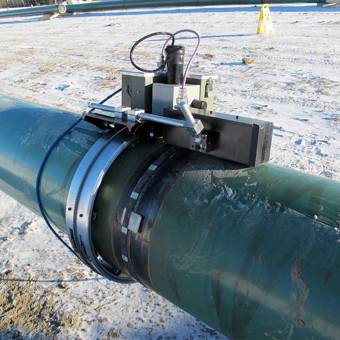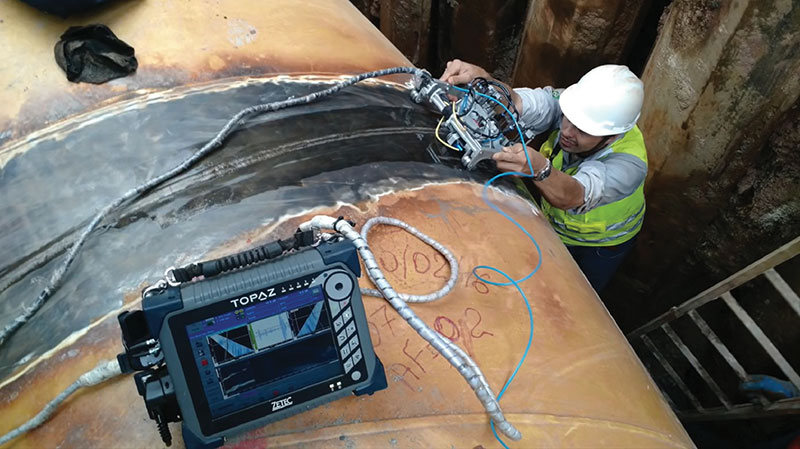Quality Assurance Ensured: Expert Pipeline Welding Inspection Services
Quality Assurance Ensured: Expert Pipeline Welding Inspection Services
Blog Article
Comprehensive Introduction of Pipe Welding Assessment Procedures
In the realm of pipeline building and construction, making sure the stability and safety and security of welded joints is paramount. Pipe welding evaluation treatments play an essential role in guaranteeing that bonded connections satisfy rigid industry standards and requirements. From thorough pre-welding evaluations to detailed post-weld evaluations, a well-defined assessment procedure is vital for preserving the architectural stability of pipes. Recognizing the ins and outs of welding assessment treatments is not only a governing requirement yet also an essential element of upholding the dependability of these critical facilities.
Pre-welding Evaluation Preparations
Prior to starting the welding procedure, thorough pre-welding assessment preparations are vital to ensure the stability and quality of the weld joint. These prep work include a precise assessment of the products to be bonded, the welding equipment, and the workplace. The materials have to be checked for any kind of problems, pollutants, or variances that might jeopardize the weld. This includes monitoring for proper material qualities, dimensions, and surface problems. Pipeline Welding Inspection. Furthermore, the welding equipment needs to be evaluated to verify that it remains in excellent functioning problem, calibrated appropriately, and appropriate for the specific welding procedure. Any type of issues with the equipment should be addressed promptly to stop defects in the weld. The work setting need to be evaluated for sanitation, correct ventilation, and safety and security procedures to ensure a favorable setup for the welding operation. By performing complete pre-welding assessment preparations, possible problems can be determined and settled beforehand, bring about top notch and trusted weld joints.
Welding Treatment Qualification
Thorough pre-welding inspection preparations lay the foundation for the important process of Welding Treatment Qualification, ensuring the stability and top quality of the weld joint. Welding Treatment Certification (WPQ) is a vital action in the welding procedure that entails screening and certifying welding treatments to assure they meet details standards and demands. The WPQ procedure generally includes welding treatment specification advancement, welding treatment qualification screening, and documents of the results.
Throughout welding treatment spec advancement, important details such as the welding process, welding materials, joint style, and welding criteria are specified to create a thorough treatment. Ultimately, welding procedure qualification testing is conducted to verify the proposed procedure's honesty. This screening frequently entails welding examination vouchers that undergo various mechanical and non-destructive examinations to examine the weld's quality and adherence to the specified requirements.
In-process Weld Assessment
Throughout the welding procedure, in-process weld evaluation plays a crucial duty in making sure the high quality and integrity of the weld joint - Pipeline Welding Inspection. This sort of assessment involves checking the welding parameters, assessing the weld grain development, and discovering any kind of prospective defects or gaps as they occur. By carrying out in-process weld examinations, welding operators can promptly deal with any problems that might occur, thereby avoiding additional problems and guaranteeing that the last weld meets the called for specs
Typical methods utilized for in-process weld evaluation consist of aesthetic inspection, liquid penetrant testing, magnetic particle testing, ultrasonic screening, click this and radiographic screening. Visual examination is often the initial step at the same time, enabling inspectors to visually examine the weld for surface abnormalities such as cracks, porosity, or incomplete combination. Much more sophisticated techniques like ultrasonic screening and radiographic screening offer thorough insights into the inner framework of the weld, ensuring that there are no concealed problems that might compromise the weld joint's strength and stability. Generally, in-process weld examination is essential for keeping the quality and integrity of welded pipes.
Non-destructive Testing (NDT)
Non-destructive Screening (NDT) is an important approach used in pipe welding inspection to examine the stability of weld joints without creating damage to the welded framework. By making use of numerous NDT methods, examiners can examine the top quality of welds and recognize any kind of problems or interruptions that may compromise the architectural soundness of the pipe. Usual NDT methods made use of in pipeline welding evaluation include Radiographic Screening (RT), Ultrasonic Testing (UT), Magnetic Bit Examining (MPT), Fluid Penetrant Testing (LPT), and Visual see here Testing (VT)
RT entails the usage of X-rays or gamma rays to generate pictures of the inner structure of the weld, permitting inspectors to identify defects such as porosity, cracks, or incomplete fusion. In addition, VT involves aesthetic evaluation of welds to determine any noticeable imperfections.
Post-weld Inspection and Documentation


Documentation of post-weld assessment findings is important for preserving high quality control documents and making certain compliance with sector criteria and policies. Thorough reports should consist of information regarding the evaluation approaches used, the area and nature of any kind of defects discovered, and any type of restorative activities taken - Pipeline Welding Inspection. Proper paperwork not just acts as a record of the weld's top quality however also help in future maintenance and assessment processes
Conclusion

In conclusion, pipe welding examination procedures play a vital function in making certain the top quality and honesty of welds. In general, adherence to appropriate evaluation procedures is key to the success of pipeline welding projects.
From thorough pre-welding assessments to comprehensive post-weld evaluations, a well-defined evaluation procedure is necessary her latest blog for preserving the structural strength of pipelines. By conducting in-process weld evaluations, welding operators can immediately attend to any kind of issues that might develop, thus protecting against additional problems and ensuring that the last weld satisfies the needed specs.
Usual methods made use of for in-process weld assessment include aesthetic assessment, fluid penetrant testing, magnetic fragment testing, ultrasonic testing, and radiographic screening.Non-destructive Screening (NDT) is a crucial technique utilized in pipe welding examination to examine the honesty of weld joints without creating damages to the bonded framework. Post-weld evaluation involves different techniques to assess the welds for issues, consisting of visual inspection, dye penetrant screening, magnetic particle testing, ultrasonic screening, and radiographic testing.
Report this page